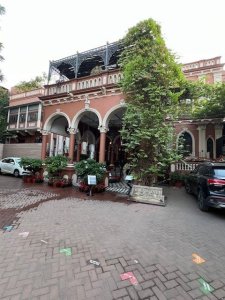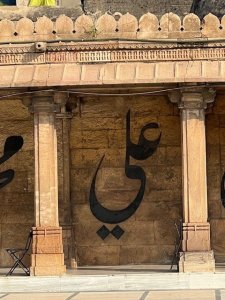Tod Tour Part Two
Every day I am just overcome with the vastness of India as I follow our journey on the map. We travel for 6 or 8 hours and in my mind, I feel we should have covered at least half of Gujarat but when I look at the map, all I see is that we have travelled between two tiny pinpricks hardly a centimetre apart! This makes me think of Tod and how he managed his journey which must have been very slow but not leisurely as he travelled through dense bush and jungle with all the attendant dangers of becoming unwell and, of course, facing lions, snakes and leopards.
The success of our journey is the result of the meticulous preparation and care that Liz Driver has taken with our itinerary. Every evening, she gives a lecture closely following Tod’s observations and the history of the places we are due to visit the next day.

We also have a wonderful driver who manoeuvres our bus through narrow lanes of villages filled with tuks tuks, cows, buffaloes and people not to mention the occasional cavalcade of lorries, cars motorbikes traveling in the wrong direction.

His cheerful assistant keeps us hydrated with bottles of water:

And last, but not least, is the wonderful Jatin who suffers our constant requests, finds the way to places that no one knows, seeks out the keepers of buildings who hold the keys, and all the time remains remarkably sane and good-humoured. I asked him how he managed to keep his composure and his reply was that he always dealt with good people so there were no problems!!


Days 6-8
We are now in Gujarat which is DRY!! So, no more gin and tonics or lime sodas. It was a long ride to Ahmedabad, the ‘Manchester of India’ famed for its textiles and Gujarat’s largest city, founded in 1411 by Sultan Ahmed Shah. On the way, we visited Rani ki Vav the Queen’s stepwell in Patan which had been the capital of Gujarat between the 8th and 15th centuries. Its construction is attributed to Udayamati, the spouse of the 11th-century Chaulukya King Bhima I. When Tod visited the site, it was silted over and it was only rediscovered in the 1940s. This stepwell is designed as an inverted temple divided into seven levels of stairs with panels containing sculptures.

We followed the canals that must once have been filled with water until we reached the mausoleum of Bairam Khan (1501-61), commander-in-chief of the Mughal army and chief mentor, advisor, and teacher of the Mughal Emperor Akbar who was murdered on his way to Mecca to perform hajj. He had fallen out with the Emperor and was told he could stay in the palace, but not act as a minister or go on a pilgrimage to Mecca. While travelling through Gujarat, he was assassinated by Haji Khan Mewati of Alwar, who was the general and close confidant of the Hindu King of North India, Hemu, who was beheaded by Bairam Khan after the Battle of Panipat in 1559. Haji Khan attacked and killed Bairam Khan, to revenge Hemu’s death. Bairam Khan died on 31 January 1561. However, his son and wife were allowed to go free and sent to north India. Bairam Khan’s wife, who was also the cousin of Akbar, married Akbar after Bairam Khan’s death. Later on, Bairam’s son, Abdul Rahim Khan-i-Khanan, was appointed as one of the ‘Nau-rattans’ (Nine Gems) of Akbar.

Before we left Patan, we visited one silk workshop producing Patola saris which are distinguished by their double ikat weave and are valued throughout Asia. Gujarati patolas were exported to Sumatra where they strongly influenced local ikat designs.

We also visited the Sun Temple at Modhera, one of the finest examples of Solanki Rajput architecture, built in 1026 during the reign of Raja Bhimdev. The temple was planned with astronomical precision to allow the flow of sunlight through its entrance and hallways. The forecourt has a large stepped tank, the Surya Kund, and the steps are lined with miniature carved shrines and the exterior walls are covered with exquisite carvings.


In Ahmedabad we stayed at the former home of Mangaldas-Girdhardas, a textile magnate, now transformed into a heritage hotel by the family. We dined every evening on the roof terrace sampling typical Gujarati cuisine.


We were disappointed to learn, just the day before, that the Calico Museum would not accommodate our visit because the employee responsible for processing visits had left. Liz had applied over a year ago and was assured that tickets would be given to us a week before our visit. However, we were not deterred and made new plans. Accompanied by Nirav Panchal who now runs a small textile business employing women who have found themselves in very unfortunate circumstances ( he gave examples of rescuing women who had been sold into prostitution by their relatives), Threads of India provides support allowing employees to make their way back to a safer and relatively easier life. He took us on a walk through the ‘pols’, the old quarters of the city.

We passed a large group of people preparing the cords used for kites in the annual kite festival to be held in January 2025. Various pots contained boiled rice paste to which crushed glass was then added and the lines coloured in red.

We visited the mosque of Ahmed Shah constructed in 1414 at the centre of the city where the pillars inside the mosque had been taken from Hindu/Jain temples, and some still possess Hindu figures. Later that day Nirav took us to his home for a delicious lunch cooked by his wife.




From Ahmedabad, we travelled on to Bhavnagar (Gandhi went to university here) where we stayed at the Nilimbagh Palace built in 1879 which had originally been home to the Gohil family who were Rajputs. On independence, Maharaja Krishna Kumar Singhji was one of the the first princes to accede to India in 1948. On our first evening, we were entertained by a charming group of young children, who attend a school in the palace grounds, performing a local dance.

The next morning a brave party of 5 set off at 4.00am to visit the temples at Palitana which are considered sacred by the Jains. There are approximately 863 marble carved temples on the hills and the main temple is reached by climbing 3500 steps. Those who were not so adventurous rose at a more suitable hour and visited the town of Bhavnagar which had been established in 1723 by Maharaja Bhavsinhji Gohil who moved the capital from Sihor some 20 km away. It was an important centre of maritime trade importing commodities from Zanzibar, Singapore and the Persian Gulf.

More to come: the Gir Forest, Junagardh, Khambat,
Dr Alison Ohta, Royal Asiatic Society Director, 29 November 2024.

